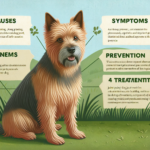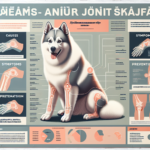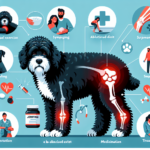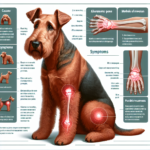Norwich Terrier Joint Pain: Causes, Symptoms, Prevention, and Treatment

Introduction
The Norwich Terrier is a small, spirited breed known for its friendly demeanor and tenacious nature. Originating from England, this breed was initially developed for hunting small vermin. With a compact, sturdy build and a distinctive wiry coat, the Norwich Terrier is both a charming companion and a capable working dog. Despite their robust appearance, Norwich Terriers are prone to certain health issues, including joint pain, which can significantly impact their quality of life.
Joint health is a critical aspect of overall well-being for Norwich Terriers. Given their active lifestyle and genetic predispositions, maintaining healthy joints is essential to ensure they remain agile and pain-free throughout their lives. This article delves into the causes, symptoms, prevention, and treatment of joint pain in Norwich Terriers, providing a comprehensive guide for owners to keep their pets healthy and happy.
Breed-Specific Joint Pain Risks
Genetic Predisposition
Norwich Terriers, like many purebred dogs, have a genetic predisposition to certain joint-related issues. Hip dysplasia, a condition where the hip joint doesn’t fit properly into the hip socket, is one such concern. This misalignment can lead to arthritis and significant pain over time. Elbow dysplasia, another hereditary condition, affects the elbow joint and can cause similar issues. Additionally, Norwich Terriers may be prone to patellar luxation, where the kneecap dislocates from its normal position, leading to discomfort and mobility problems.
Age-Related Risks
As Norwich Terriers age, the risk of developing joint pain increases. The wear and tear on their joints over the years can lead to conditions like osteoarthritis, where the cartilage that cushions the joints deteriorates. Owners should be particularly vigilant as their Norwich Terrier approaches middle age, typically around 5-7 years old, as this is when joint issues may start to manifest more prominently.
Activity Level and Joint Stress
Norwich Terriers are known for their high energy levels and love for physical activity. While regular exercise is crucial for their overall health, excessive or inappropriate activity can put undue stress on their joints. Activities that involve a lot of jumping or sudden stops and starts can be particularly hard on their joints, potentially leading to injuries or exacerbating existing conditions.
Common Symptoms of Joint Pain in Norwich Terriers
General Symptoms
Owners should be aware of several common symptoms that may indicate joint pain in their Norwich Terrier:
- Limping: A noticeable limp or favoring one leg over another can be a sign of joint pain.
- Stiffness: Difficulty in getting up or moving, especially after resting, is a common symptom.
- Reluctance to Move: A dog that is hesitant to jump, climb stairs, or engage in usual activities may be experiencing joint pain.
- Swelling: Visible swelling around the joints can indicate inflammation and pain.
- Behavioral Changes: Increased irritability or changes in behavior can also be a sign of discomfort.
Breed-Specific Symptoms
In Norwich Terriers, joint pain may also manifest in more subtle ways. Given their typically active and playful nature, a sudden decrease in energy or enthusiasm for play can be a red flag. Additionally, they may exhibit a change in posture, such as a hunched back or an altered gait, to compensate for the pain.
When to Consult a Vet
If any of the above symptoms are observed, it is crucial to consult a veterinarian promptly. Early diagnosis and intervention can significantly improve the prognosis and quality of life for a Norwich Terrier suffering from joint pain. Regular veterinary check-ups are also essential for early detection and management of joint issues.
Preventive Measures for Joint Health
Exercise Recommendations
Regular, moderate exercise is key to maintaining joint health in Norwich Terriers. Activities such as walking, swimming, and gentle play are excellent choices. These exercises help keep the joints flexible and muscles strong without putting excessive strain on them. Avoid high-impact activities like jumping or running on hard surfaces, which can exacerbate joint issues.
Dietary Suggestions
A balanced diet rich in essential nutrients is vital for joint health. Foods containing glucosamine and chondroitin can support cartilage health, while omega-3 fatty acids have anti-inflammatory properties that can help reduce joint pain. Consider incorporating high-quality commercial dog foods formulated for joint health or adding supplements as recommended by a veterinarian.
Weight Management
Maintaining a healthy weight is crucial for reducing stress on the joints. Overweight dogs are at a higher risk of developing joint problems due to the additional load on their joints. Regular exercise combined with a balanced diet can help keep a Norwich Terrier at an optimal weight. Consult with a veterinarian to determine the ideal weight for your dog and develop a weight management plan if necessary.
Early Screening and Monitoring
Early screening for joint issues can help catch problems before they become severe. Regular veterinary check-ups should include assessments of joint health, especially as the dog ages. For breeds like the Norwich Terrier, specific screening tests such as X-rays or genetic testing for predispositions to joint conditions can be beneficial.
Treatment Options for Joint Pain
Non-Surgical Treatments
For many Norwich Terriers, non-surgical treatments can effectively manage joint pain. These may include:
- Medications: Nonsteroidal anti-inflammatory drugs (NSAIDs) can help reduce pain and inflammation. Other medications like pain relievers or joint supplements may also be prescribed.
- Physical Therapy: Therapeutic exercises and treatments such as hydrotherapy can improve joint function and reduce pain.
- Lifestyle Adjustments: Modifying the dog’s activity level and providing a comfortable living environment can help manage symptoms.
Surgical Options
In severe cases, surgical intervention may be necessary. Common surgical options for joint pain in Norwich Terriers include:
- Arthroscopy: A minimally invasive procedure to diagnose and treat joint issues.
- Joint Replacement: In cases of severe arthritis, joint replacement surgery may be considered.
- Corrective Surgery: Procedures to correct structural issues like hip or elbow dysplasia.
Alternative Therapies
Alternative therapies can complement traditional treatments and provide additional relief. These may include:
- Acupuncture: This ancient practice can help reduce pain and improve joint function.
- Hydrotherapy: Water-based exercises that reduce stress on the joints while improving strength and mobility.
- Massage: Regular massage can help alleviate muscle tension and improve circulation around the joints.
Lifestyle and Management Tips
Daily Care Routine
A consistent daily care routine can help manage joint pain in Norwich Terriers. This may include:
- Regular, gentle exercise tailored to the dog’s abilities.
- A balanced diet with joint-supporting nutrients.
- Administering any prescribed medications or supplements.
- Monitoring the dog’s weight and adjusting food intake as needed.
Modifying the Home Environment
Making the home environment more comfortable can significantly improve a dog’s quality of life. Consider the following modifications:
- Ramps: Install ramps to help the dog navigate stairs or get onto furniture without jumping.
- Orthopedic Beds: Provide a supportive bed to reduce pressure on the joints during rest.
- Non-Slip Flooring: Ensure floors are non-slip to prevent falls and injuries.
Long-Term Management
Long-term management strategies are essential for keeping a Norwich Terrier active and happy despite joint pain. These may include:
- Regular veterinary check-ups to monitor joint health and adjust treatments as needed.
- Consistent exercise and weight management to maintain joint function.
- Ongoing use of supplements or medications as prescribed by a veterinarian.
FAQs About Norwich Terriers and Joint Pain
What are the early signs of joint pain in Norwich Terriers?
Early signs of joint pain include limping, stiffness, reluctance to move, and changes in behavior such as increased irritability or decreased enthusiasm for play.
Can joint pain in Norwich Terriers be prevented?
While genetic predispositions cannot be entirely prevented, maintaining a healthy weight, providing appropriate exercise, and ensuring a balanced diet with joint-supporting nutrients can help reduce the risk of joint pain.
Are there specific exercises that are better for Norwich Terriers with joint pain?
Yes, low-impact exercises such as walking and swimming are ideal for Norwich Terriers with joint pain. These activities help maintain joint flexibility and muscle strength without putting excessive strain on the joints.
When should I consult a vet about my Norwich Terrier’s joint pain?
If you notice any signs of joint pain, such as limping, stiffness, or reluctance to move, it is important to consult a veterinarian promptly. Early diagnosis and treatment can significantly improve the prognosis.
What dietary supplements can help with joint pain in Norwich Terriers?
Supplements containing glucosamine, chondroitin, and omega-3 fatty acids can support joint health and reduce inflammation. Always consult with a veterinarian before adding supplements to your dog’s diet.
Conclusion
Joint pain is a significant concern for Norwich Terriers, but with proper care and attention, it can be managed effectively. By understanding the causes, symptoms, and preventive measures, owners can take proactive steps to ensure their Norwich Terrier remains healthy and active. Regular veterinary check-ups, a balanced diet, appropriate exercise, and a comfortable living environment are key components of maintaining joint health. By staying vigilant and responsive to their dog’s needs, owners can help their Norwich Terrier lead a happy, pain-free life.




